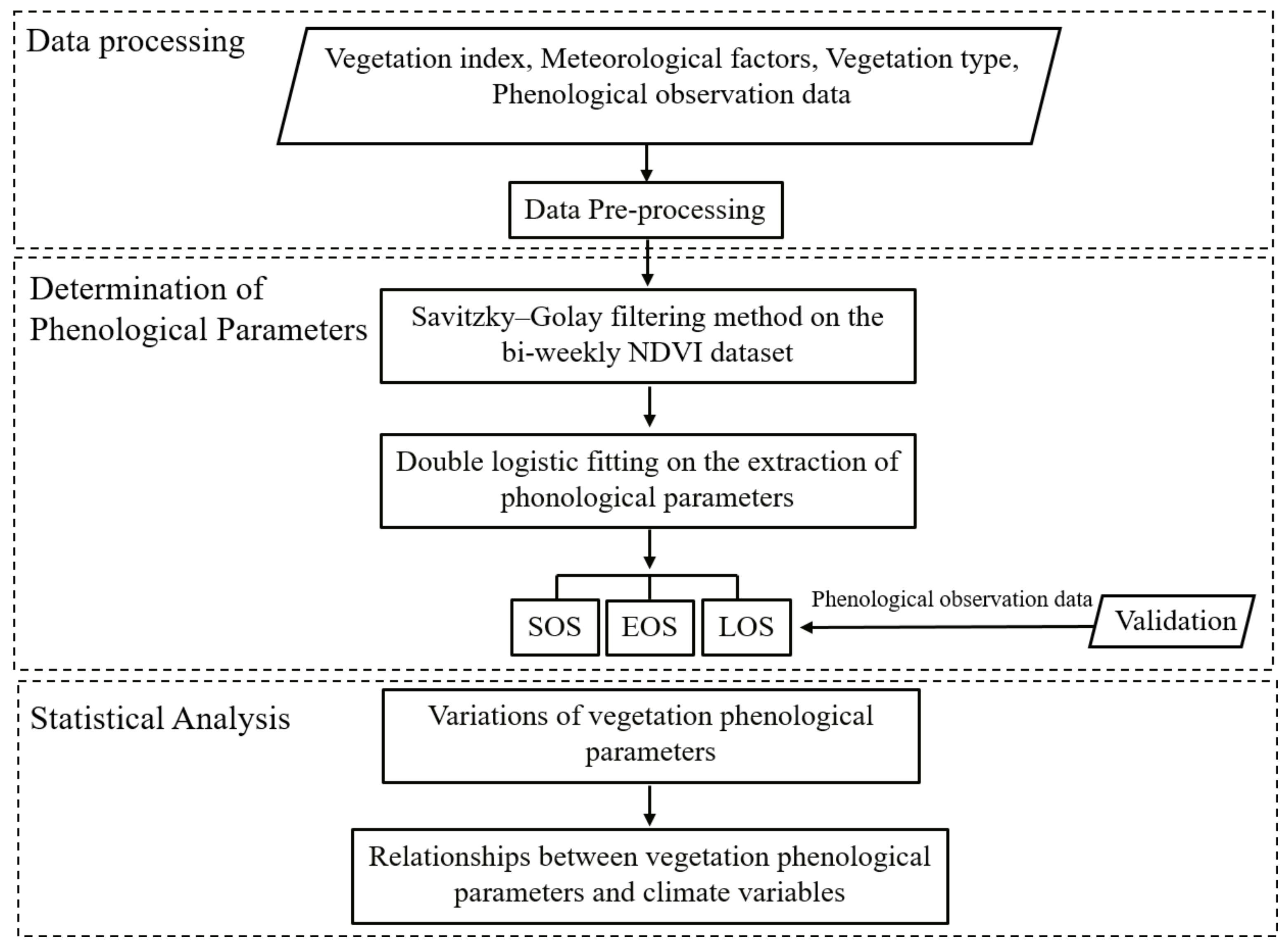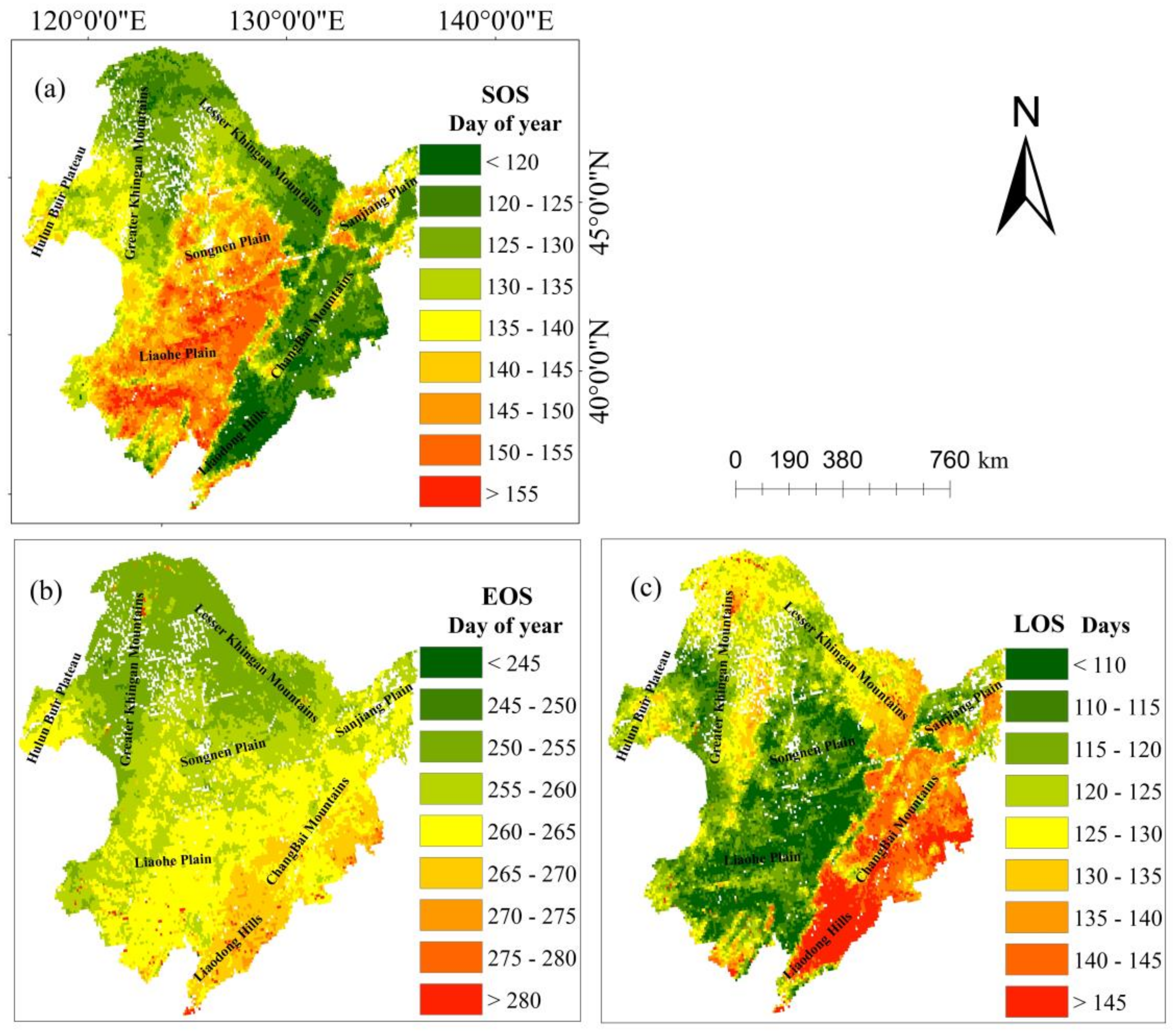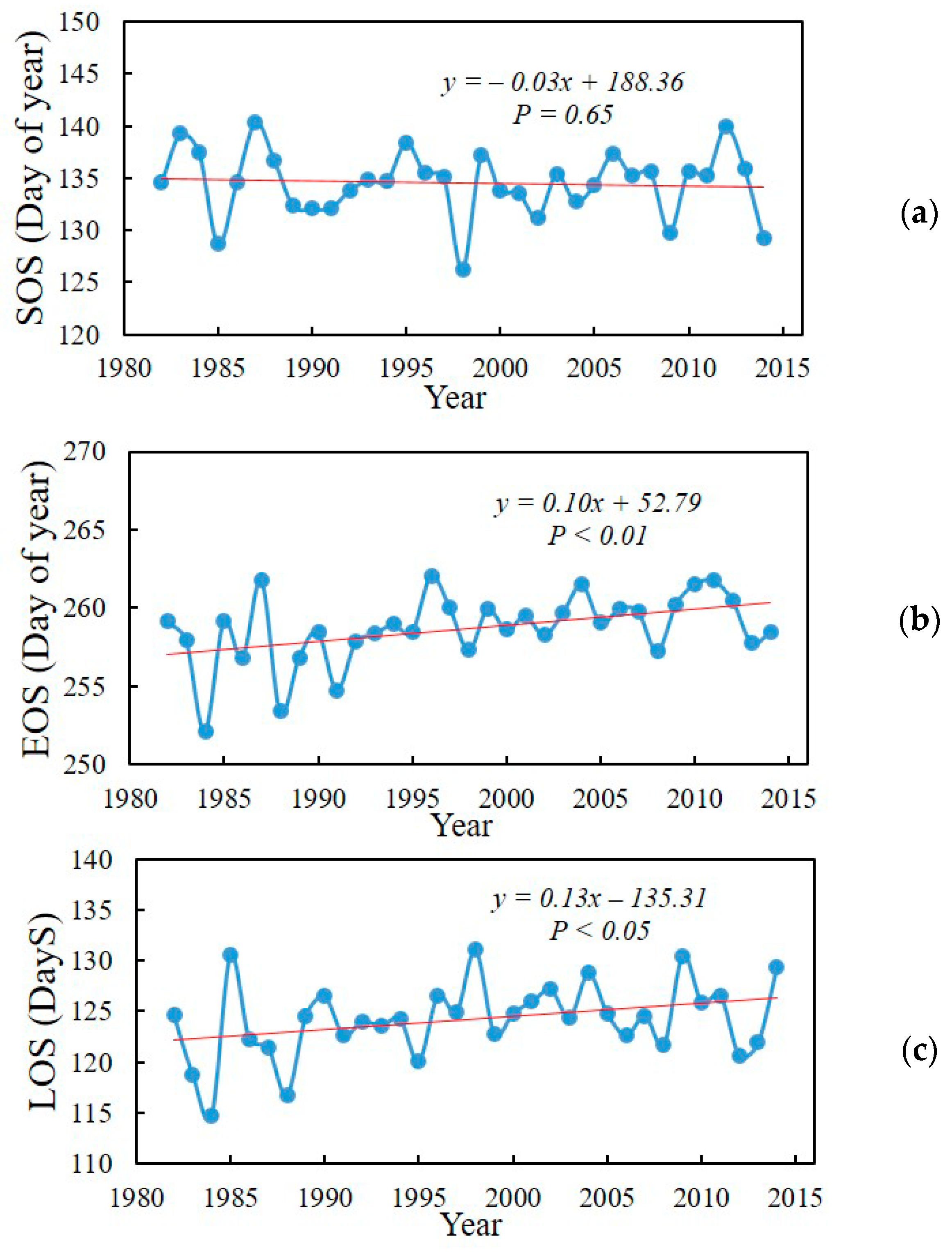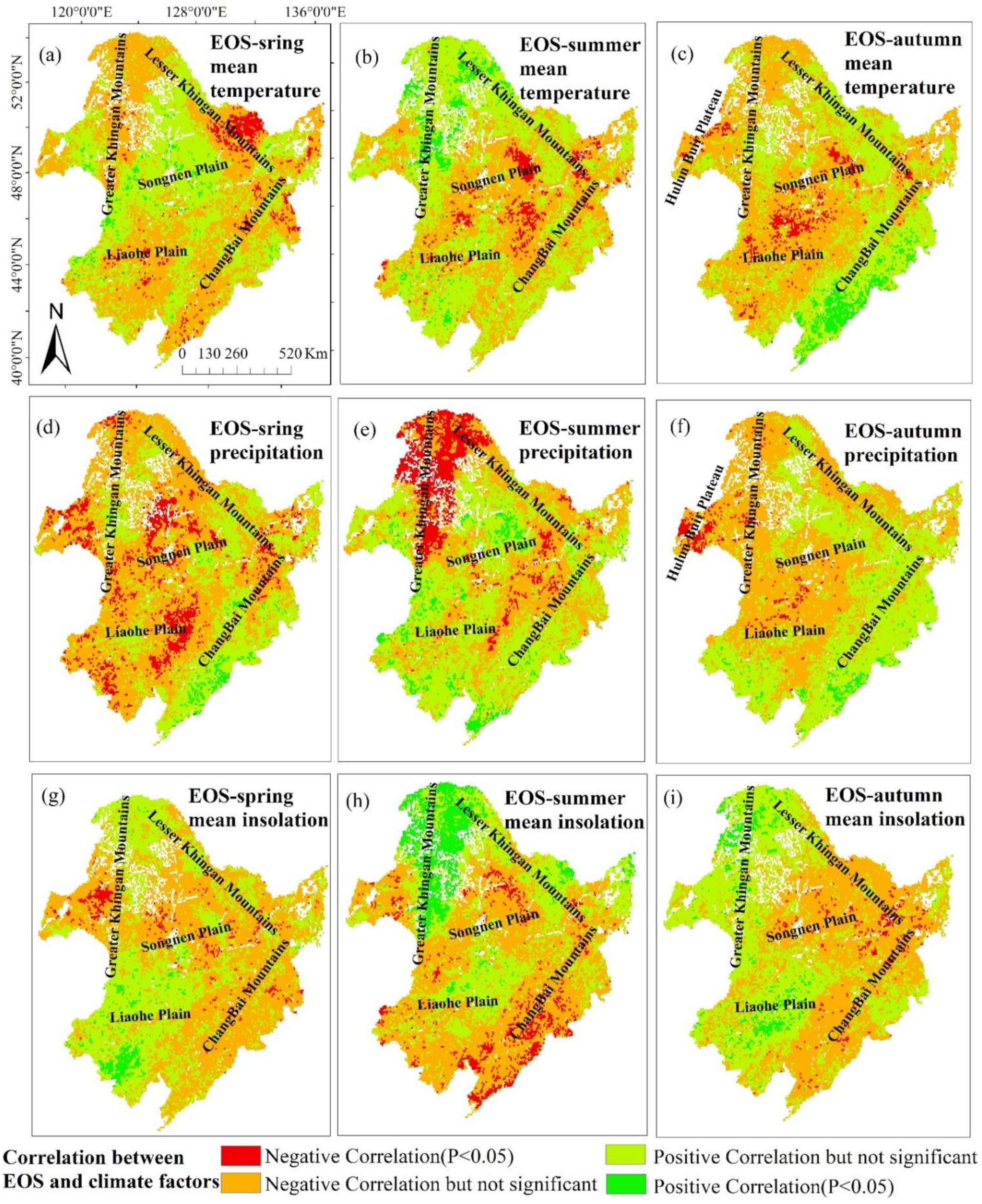Spatiotemporal Variations in Satellite-Derived Vegetation Phenological Parameters in Northeast China
Abstract
:1. Introduction
2. Data and Methods
2.1. Study Area
2.2. Data Sources
2.3. Statistical Analysis
3. Results
3.1. Spatial Distribution of Vegetation Phenological Parameters
3.2. Variations of Vegetation Phenological Parameters
3.2.1. Temporal Variations in Vegetation Phenological Parameters at the Regional Scale
3.2.2. Spatial Pattern of Change Trends in The Vegetation Phenological Parameters
3.3. Relationships between Vegetation Phenological Parameters and Climate Variables
3.3.1. Relationships between Vegetation Phenological Parameters and Climate Variables at the Regional Scale
3.3.2. Relationships between Vegetation Phenological Parameters and Climate Variables at the Pixel Scale
3.4. Phenological Parameters of Different Vegetation Types
3.4.1. Temporal Variations in Phenological Parameters within Different Vegetation Types
3.4.2. Relationships between Vegetation Phenological Parameters and Climate Variables within Different Vegetation Types
4. Discussion
4.1. Variations in Vegetation Phenological Parameters over the Last 33 Years
4.2. Relationships between Vegetation Phenological Parameters and Climate Factors
4.3. Uncertainties
5. Conclusions
- The SOS exhibited a slight advancing trend, and the EOS showed an obvious delaying trend. Meanwhile, the LOS presented an obvious prolonging trend at the regional scale.
- At the different vegetation types scale, the SOS for the forest and the grass showed non-significant advancing trends, while there was a weak delay for the cultivated land. The EOS exhibited delaying trends for forest, cultivated land, and grassland. The opposite change trends in the earlier SOS and the later EOS enhanced LOS in forest and grassland. The LOS for cultivated land showed a non-significant increasing trend.
- The pixels showing significant earlier trends in the SOS accounted for 19.1% of the whole research area with the leading distribution in the Great Khingan Mountains, Lesser Khingan Mountains, and Liaodong Hills, while the pixels that showed significant delayed trends in the SOS accounted for 13.1% and were mostly found in the plains. The EOS exhibited a delaying trend in most of the study region (approximately 72.1%) except for the Liaohe Plain and the Hulun Buir Plateau. Due to the changes in SOS and EOS, there were clear changes in the LOS of northeast China. The LOS in 29.7% of the whole study area exhibited obvious prolonged trends.
- According to the correlation of vegetation phenology with climate factors, the SOS had an obviously negative correlation with spring mean temperature and the EOS was obviously negatively connected to summer total precipitation at the regional scale. For the forest areas, the warmer spring temperature may result in an earlier SOS. In the cultivated areas, the precipitation and insolation in spring were the main drivers of SOS. In the grassland areas, there existed an obvious negative correlation between the SOS and the spring mean insolation. A significant negative correlation was observed between the EOS and the summer total precipitation, suggesting that low rainfall in summer would lead to a later EOS in the forest areas. For the grassland areas, high rainfall in autumn may cause an advancing of the EOS. At the pixel scale, the relationships between the phenological parameters and climate variables showed strong spatial heterogeneities. In addition, the SOS was dominated by the spring temperature in most forest areas. The EOS in northern forests was dominated by summer precipitation and summer insolation, whereas the EOS in southern forests was governed by autumn temperature. The EOS in the Hulun Buir Plateau, which is dominated by grassland, was related to autumn precipitation, and the EOS in cultivated land was governed by various factors including summer temperature, autumn temperature, spring precipitation, and autumn insolation.
Supplementary Materials
Author Contributions
Funding
Acknowledgments
Conflicts of Interest
References
- Jeong, S.J.; Ho, C.H.; Gim, H.J.; Brown, M.E. Phenology shifts at start vs. End of growing season in temperate vegetation over the northern hemisphere for the period 1982–2008. Glob. Chang. Biol. 2011, 17, 2385–2399. [Google Scholar] [CrossRef]
- Tang, H.; Li, Z.W.; Zhu, Z.L.; Chen, B.R.; Zhang, B.H.; Xin, X.P. Variability and climate change trend in vegetation phenology of recent decades in the greater khingan mountain area, northeastern China. Remote Sens. 2015, 7, 11914. [Google Scholar] [CrossRef] [Green Version]
- Zu, J.X.; Yang, J. Temporal variation of vegetation phenology in northeastern China. Acta Ecol. Sin. 2016, 36, 2015–2023. (In Chinese) [Google Scholar] [CrossRef]
- Peñuelas, J.; Filella, I. Responses to a warming world. Science 2001, 294, 793–795. [Google Scholar] [CrossRef] [PubMed]
- Zhou, L.; Tucker, C.J.; Kaufmann, R.K.; Slayback, D.; Shabanov, N.V.; Myneni, R.B. Variations in northern vegetation activity inferred from satellite data of vegetation index during 1981 to 1999. J. Geophys. Res. Atmos. 2001, 106, 20069–20083. [Google Scholar] [CrossRef]
- Liu, Q.; Fu, Y.S.H.; Zeng, Z.Z.; Huang, M.T.; Li, X.R.; Piao, S.L. Temperature, precipitation, and insolation effects on autumn vegetation phenology in temperate China. Glob. Change Biol. 2016, 22, 644–655. [Google Scholar] [CrossRef] [PubMed]
- Richardson, A.D.; Keenan, T.F.; Migliavacca, M.; Ryu, Y.; Sonnentag, O.; Toomey, M. Climate change, phenology, and phenological control of vegetation feedbacks to the climate system. Agric. For. Meteorol. 2013, 169, 156–173. [Google Scholar] [CrossRef]
- Wang, S.Y.; Yang, B.J.; Yang, Q.C.; Lu, L.L.; Wang, X.Y.; Peng, Y.Y. Temporal trends and spatial variability of vegetation phenology over the northern hemisphere during 1982–2012. PLoS ONE 2016, 11, e0157134. [Google Scholar] [CrossRef]
- Wu, C.; Gonsamo, A.; Gough, C.M.; Chen, J.M.; Xu, S. Modeling growing season phenology in north american forests using seasonal mean vegetation indices from modis. Remote Sens. Environ. 2014, 147, 79–88. [Google Scholar] [CrossRef]
- Suzuki, R.; Nomaki, T.; Yasunari, T. West–east contrast of phenology and climate in northern asia revealed using a remotely sensed vegetation index. Int. J. Biometeorol. 2003, 47, 126–138. [Google Scholar] [CrossRef]
- Piao, S.L.; Fang, J.Y.; Zhou, L.M.; Ciais, P.; Zhu, B. Variations in satellite-derived phenology in China′s temperate vegetation. Glob. Change Biol. 2006, 12, 672–685. [Google Scholar] [CrossRef]
- Garrity, S.R.; Bohrer, G.; Maurer, K.D.; Mueller, K.L.; Vogel, C.S.; Curtis, P.S. A comparison of multiple phenology data sources for estimating seasonal transitions in deciduous forest carbon exchange. Agric. For. Meteorol. 2011, 151, 1741–1752. [Google Scholar] [CrossRef]
- Tucker, C.J.; Slayback, D.A.; Pinzon, J.E.; Los, S.O.; Myneni, R.B.; Taylor, M.G. Higher northern latitude normalized difference vegetation index and growing season trends from 1982 to 1999. Int. J. Biometeorol. 2001, 45, 184–190. [Google Scholar] [CrossRef] [PubMed]
- Zhang, X.; Friedl, M.A.; Schaaf, C.B.; Strahler, A.H.; Hodges, J.C.F.; Gao, F.; Reed, B.C.; Huete, A. Monitoring vegetation phenology using modis. Remote Sens. Environ. 2003, 84, 471–475. [Google Scholar] [CrossRef]
- Wu, C.Y.; Hou, X.H.; Peng, D.L.; Gonsamo, A.; Xu, S.G. Land surface phenology of China′s temperate ecosystems over 1999–2013: Spatial–temporal patterns, interaction effects, covariation with climate and implications for productivity. Agric. For. Meteorol. 2016, 216, 177–187. [Google Scholar] [CrossRef]
- Chen, X.Q.; Hu, B.; Yu, R. Spatial and temporal variation of phenological growing season and climate change impacts in temperate eastern China. Glob. Chang. Biol. 2005, 11, 1118–1130. [Google Scholar] [CrossRef]
- De Beurs, K.M.; Henebry, G.M. Land surface phenology and temperature variation in the international geosphere–biosphere program high-latitude transects. Glob. Chang. Biol. 2005, 11, 779–790. [Google Scholar] [CrossRef]
- Jeong, S.J.; Ho, C.H.; Jeong, J.H. Increase in vegetation greenness and decrease in springtime warming over East Asia. Geophys. Res. Lett. 2009, 36, L02710. [Google Scholar] [CrossRef]
- Yu, L.X.; Liu, T.X.; Bu, K.; Yan, F.Q.; Yang, J.C.; Chang, L.P.; Zhang, S.W. Monitoring the long term vegetation phenology change in northeast China from 1982 to 2015. Sci. Rep. 2017, 7, 14770. [Google Scholar] [CrossRef] [Green Version]
- Reed, B.C.; Brown, J.F.; VanderZee, D.; Loveland, T.R.; Merchant, J.W.; Ohlen, D.O. Measuring Phenological Variability from Satellite Imagery. J. Veg. Sci. 1994, 5, 703–714. [Google Scholar] [CrossRef]
- Fisher, J.I.; Mustard, J.F.; Vadeboncoeur, M.A. Green leaf phenology at Landsat resolution: Scaling from the field to the satellite. Remote Sens. Environ. 2006, 100, 265–279. [Google Scholar] [CrossRef]
- Fisher, J.I.; Mustard, J.F. Cross-Scalar Satellite Phenology from Ground, Landsat, and MODIS Data. Remote Sens. Environ. 2007, 100, 261–273. [Google Scholar] [CrossRef]
- Myneni, R.B.; Keeling, C.D.; Tucker, C.J.; Asrar, G.; Nemani, R.R. Increased plant growth in the northern high latitudes from 1981 to 1991. Nature 1997, 386, 698. [Google Scholar] [CrossRef]
- Zhu, W.Q.; Tian, H.Q.; Xu, X.F.; Pan, Y.Z.; Chen, G.S.; Lin, W.P. Extension of the growing season due to delayed autumn over mid and high latitudes in north america during 1982–2006. Glob. Ecol. Biogeogr. 2012, 21, 260–271. [Google Scholar] [CrossRef]
- Jeganathan, C.; Dash, J.; Atkinson, P.M. Remotely sensed trends in the phenology of northern high latitude terrestrial vegetation, controlling for land cover change and vegetation type. Remote Sens. Environ. 2014, 143, 154–170. [Google Scholar] [CrossRef]
- Zhao, J.J.; Zhang, H.Y.; Zhang, Z.X.; Guo, X.Y.; Li, X.D.; Chen, C. Spatial and temporal changes in vegetation phenology at middle and high latitudes of the northern hemisphere over the past three decades. Remote Sens. 2015, 7, 10973. [Google Scholar] [CrossRef] [Green Version]
- Wu, X.C.; Liu, H.Y. Consistent shifts in spring vegetation green-up date across temperate biomes in China, 1982–2006. Glob. Chang. Biol. 2013, 19, 870–880. [Google Scholar] [CrossRef]
- Yang, Y.T.; Guan, H.D.; Shen, M.G.; Liang, W.; Jiang, L. Changes in autumn vegetation dormancy onset date and the climate controls across temperate ecosystems in China from 1982 to 2010. Glob. Chang. Biol. 2015, 21, 652–665. [Google Scholar] [CrossRef]
- Li, Z.G.; Tang, H.J.; Yang, P.; Wu, W.B.; Chen, Z.X.; Zhou, Q.B.; Zhang, L.; Zou, J.Q. Spatio-temporal responses of cropland phenophases to climate change in northeast China. J. Geogr. Sci. 2012, 22, 29–45. [Google Scholar] [CrossRef]
- Ren, G.Y.; Xu, M.Z.; Chu, Z.Y.; Guo, J.; Li, Q.X.; Liu, X.; Wang, Y. Change of surface air temperature in China during 1951–2004. Clim. Environ. Res. 2005, 10, 717–727. (In Chinese) [Google Scholar] [CrossRef]
- Zhao, J.J.; Wang, Y.Y.; Zhang, Z.X.; Zhang, H.Y.; Guo, X.Y.; Yu, S.; Du, W.L.; Huang, F. The variations of land surface phenology in northeast China and its responses to climate change from 1982 to 2013. Remote Sens. 2016, 8, 400. [Google Scholar] [CrossRef] [Green Version]
- Guo, J.T.; Hu, Y.M.; Xiong, Z.P.; Yan, X.L.; Li, C.L.; Bu, R.C. Variations in growing-season ndvi and its response to permafrost degradation in northeast China. Sustainability 2017, 9, 551. [Google Scholar] [CrossRef] [Green Version]
- Wei, Z.; Jin, H.J.; Zhang, J.M.; Yu, S.P.; Han, X.J.; Ji, Y.J.; He, R.X.; Chang, X.L. Prediction of permafrost changes in northeastern China under a changing climate. Sci. China Earth Sci. 2011, 54, 924–935. [Google Scholar] [CrossRef]
- Tucker, C.J.; Pinzon, J.E.; Brown, M.E.; Slayback, D.A.; Pak, E.W.; Mahoney, R.; Vermote, E.F.; El Saleous, N. An extended avhrr 8-km ndvi dataset compatible with modis and spot vegetation ndvi data. Int. J. Remote Sens. 2005, 26, 4485–4498. [Google Scholar] [CrossRef]
- Broich, M.; Huete, A.; Paget, M.; Ma, X.L.; Tulbure, M.; Coupe, N.R.; Evans, B.; Beringer, J.; Devadas, R.; Davies, K. A spatially explicit land surface phenology data product for science, monitoring and natural resources management applications. Environ. Model. Softw. 2015, 64, 191–204. [Google Scholar] [CrossRef]
- Chen, J.; Jönsson, P.; Tamura, M.; Gu, Z.H.; Matsushita, B.; Eklundh, L. A simple method for reconstructing a high-quality ndvi time-series data set based on the savitzky–golay filter. Remote Sens. Environ. 2004, 91, 332–344. [Google Scholar] [CrossRef]
- Butt, B.; Turner, M.D.; Singh, A.; Brottem, L. Use of modis ndvi to evaluate changing latitudinal gradients of rangeland phenology in sudano-sahelian west africa. Remote Sens. Environ. 2011, 115, 3367–3376. [Google Scholar] [CrossRef]
- White, M.A.; Running, S.W.; Thornton, P.E. The impact of growing-season length variability on carbon assimilation and evapotranspiration over 88 years in the eastern us deciduous forest. Int. J. Biometeorol. 1999, 42, 139–145. [Google Scholar] [CrossRef]
- Julien, Y.; Sobrino, J.A. Global land surface phenology trends from gimms database. Int. J. Remote Sens. 2009, 30, 3495–3513. [Google Scholar] [CrossRef] [Green Version]
- Stöckli, R.; Vidale, P.L. European plant phenology and climate as seen in a 20-year avhrr land-surface parameter dataset. Int. J. Remote Sens. 2004, 25, 3303–3330. [Google Scholar] [CrossRef]
- Yu, L.X.; Zhang, S.W.; Tang, J.M.; Liu, T.X.; Bu, K.; Yan, F.Q.; Yang, C.B.; Yang, J.C. The effect of deforestation on the regional temperature in northeastern China. Theo. Appl. Climatol. 2015, 120, 761–771. [Google Scholar] [CrossRef]
- Shrestha, U.B.; Gautam, S.; Bawa, K.S. Widespread climate change in the himalayas and associated changes in local ecosystems. PLoS ONE 2012, 7, e36741. [Google Scholar] [CrossRef] [PubMed] [Green Version]
- Piao, S.L.; Mohammat, A.; Fang, J.Y.; Cai, Q.; Feng, J.M. Ndvi-based increase in growth of temperate grasslands and its responses to climate changes in China. Glob. Environ. Change 2006, 16, 340–348. [Google Scholar] [CrossRef]
- Luedeling, E.; Zhang, M.H.; McGranahan, G.; Leslie, C. Validation of winter chill models using historic records of walnut phenology. Agric. For. Meteorol. 2009, 149, 1854–1864. [Google Scholar] [CrossRef]
- Richardson, E.A.; Seeley, S.D.; Walker, D.R. A model for estimating the completion of rest for ‘redhaven’ and ‘elberta’ peach trees. HortScience 1974, 9, 331–332. [Google Scholar]
- Yu, H.Y.; Luedeling, E.; Xu, J.C. Winter and spring warming result in delayed spring phenology on the tibetan plateau. Proc. Natl. Acad. Sci. USA 2010, 107, 22151. [Google Scholar] [CrossRef] [Green Version]
- Soudani, K.; Hmimina, G.; Delpierre, N.; Pontailler, J.Y.; Aubinet, M.; Bonal, D.; Caquet, B.; de Grandcourt, A.; Burban, B.; Flechard, C.; et al. Ground-based network of ndvi measurements for tracking temporal dynamics of canopy structure and vegetation phenology in different biomes. Remote Sens. Environ. 2012, 123, 234–245. [Google Scholar] [CrossRef]
- Richardson, A.D.; Bailey, A.S.; Denny, E.G.; Martin, C.W.; O′Keefe, J. Phenology of a northern hardwood forest canopy. Glob. Chang. Biol. 2006, 12, 1174–1188. [Google Scholar] [CrossRef] [Green Version]
- Zhou, Y.Z.; Jia, G.S. Precipitation as a control of vegetation phenology for temperate steppes in China. Atmos. Ocean. Sci. Lett. 2016, 9, 162–168. [Google Scholar] [CrossRef]
- Keeling, C.D.; Chin, J.F.S.; Whorf, T.P. Increased activity of northern vegetation inferred from atmospheric co2 measurements. Nature 1996, 382, 146. [Google Scholar] [CrossRef]
- Randerson, J.T.; Field, C.B.; Fung, I.Y.; Tans, P.P. Increases in early season ecosystem uptake explain recent changes in the seasonal cycle of atmospheric co2 at high northern latitudes. Geophys. Res. Lett. 1999, 26, 2765–2768. [Google Scholar] [CrossRef] [Green Version]
- Piao, S.L.; Friedlingstein, P.; Ciais, P.; Viovy, N.; Demarty, J. Growing season extension and its impact on terrestrial carbon cycle in the northern hemisphere over the past 2 decades. Glob. Biogeochem. Cycles 2007, 21, GB3018. [Google Scholar] [CrossRef]
- Nemani, R.; White, M.; Thornton, P.; Nishida, K.; Reddy, S.; Jenkins, J.; Running, S. Recent trends in hydrologic balance have enhanced the terrestrial carbon sink in the United States. Geophys. Res. Lett. 2002, 29, 106-1–106-4. [Google Scholar] [CrossRef] [Green Version]







| Type | Variables | Dataset | Spatial Resolution | Source |
|---|---|---|---|---|
| Vegetation index (input data) | NDVI | GIMMS NDVI3g | 8 km | NASA |
| Meteorological factors (input data) | Temperature, precipitation, insolation | - | daily | China Meteorological Data Service |
| Vegetation type (input data) | Forest, grassland, cultivated land, other | 1:1,000,000 vegetation map of China | 1:1,000,000 | Institute of Geography at the Chinese Academy of Sciences |
| Phenological observation data (validation data) | Jiamusi, Mudanjiang, Nenjiang, Dedu, Haerbin, Changchun, Shenyang, and Gaizhou | - | - | Chinese Phenological Observation Network |
| Different Climate Factors | SOS | EOS |
|---|---|---|
| Previous autumn mean temperature | −0.09 | - |
| Previous winter mean temperature | −0.18 | - |
| Spring mean temperature | −0.59 ** | −0.03 |
| Summer mean temperature | - | 0.13 |
| Autumn mean temperature | - | 0.04 |
| Previous autumn total precipitation | 0.23 | - |
| Previous winter total precipitation | −0.20 | - |
| Spring total precipitation | 0.05 | 0.02 |
| Summer total precipitation | - | −0.34 * |
| Autumn total precipitation | - | −0.06 |
| Previous autumn mean insolation | 0.01 | - |
| Previous winter mean insolation | 0.16 | - |
| Spring mean insolation | −0.24 | −0.10 |
| Summer mean insolation | - | 0.23 |
| Autumn mean insolation | - | 0.01 |
| Correlation | SOS (%) | EOS (%) | |||||
|---|---|---|---|---|---|---|---|
| Previous Autumn | Previous Winter | Spring | Spring | Summer | Autumn | ||
| Temperature | Significant Negative Correlation | 2.51 | 6.10 | 47.42 | 4.18 | 4.18 | 3.88 |
| No Significant Negative Correlation | 55.53 | 57.20 | 33.54 | 50.63 | 40.22 | 51.27 | |
| No Significant Positive Correlation | 41.06 | 32.60 | 17.94 | 43.52 | 50.84 | 40.80 | |
| Significant Positive Correlation | 0.90 | 4.10 | 1.10 | 1.67 | 4.76 | 4.05 | |
| Precipitation | Significant Negative Correlation | 0.82 | 11.94 | 6.88 | 10.18 | 12.17 | 2.43 |
| No Significant Negative Correlation | 32.26 | 62.20 | 35.62 | 57.68 | 37.31 | 50.56 | |
| No Significant Positive Correlation | 62.53 | 25.00 | 54.10 | 30.66 | 46.44 | 45.31 | |
| Significant Positive Correlation | 4.39 | 0.86 | 3.40 | 1.48 | 4.08 | 1.70 | |
| Insolation | Significant Negative Correlation | 1.14 | 0.44 | 10.54 | 2.53 | 5.98 | 2.00 |
| No Significant Negative Correlation | 56.35 | 37.70 | 70.70 | 52.66 | 48.46 | 46.79 | |
| No Significant Positive Correlation | 40.73 | 55.48 | 18.56 | 42.39 | 34.18 | 46.96 | |
| Significant Positive Correlation | 1.78 | 6.37 | 0.20 | 2.42 | 11.38 | 4.25 | |
| Different Vegetation Types | SOS | EOS | LOS |
|---|---|---|---|
| Forest | –0.06 | 0.16 ** | 0.22 * |
| Cultivated land | 0.06 | 0.08 * | 0.02 |
| Grassland | –0.07 | 0.02 | 0.09 |
| Vegetation Types | Significant Decrease | No Significant Decrease | No Significant Increase | Significant Increase |
|---|---|---|---|---|
| Forest | 1804 | 4142 | 2411 | 514 |
| Cultivated land | 665 | 1731 | 2101 | 1395 |
| Grassland | 1322 | 1938 | 999 | 661 |
| Vegetation Types | Significant Decrease | No Significant Decrease | No Significant Increase | Significant Increase |
|---|---|---|---|---|
| Forest | 137 | 953 | 4572 | 3198 |
| Cultivated land | 498 | 1442 | 2450 | 1497 |
| Grassland | 526 | 1924 | 1655 | 799 |
| Vegetation Types | Significant Decrease | No Significant Decrease | No Significant Increase | Significant Increase |
|---|---|---|---|---|
| Forest | 371 | 1318 | 3690 | 3481 |
| Cultivated land | 963 | 1870 | 1994 | 1059 |
| Grassland | 544 | 1206 | 1864 | 1290 |
| Climate Factors | Vegetation Types | ||
|---|---|---|---|
| Forest | Cultivated Land | Grassland | |
| Previous autumn mean temperature | −0.02 | −0.04 | −0.23 |
| Previous winter mean temperature | -0.28 | −0.05 | 0.03 |
| Spring mean temperature | −0.70 ** | −0.36 * | −0.24 |
| Previous autumn total precipitation | 0.28 | 0.09 | 0.12 |
| Previous winter total precipitation | −0.18 | −0.11 | −0.30 |
| Spring total precipitation | 0.12 | 0.11 | −0.16 |
| Previous autumn mean insolation | −0.04 | −0.01 | 0.13 |
| Previous winter mean insolation | 0.04 | 0.25 | 0.23 |
| Spring mean insolation | −0.12 | −0.36 * | −0.36 * |
| Climate Factors | Vegetation Types | ||
|---|---|---|---|
| Forest | Cultivated Land | Grassland | |
| Spring mean temperature | −0.15 | 0.10 | 0.10 |
| Summer mean temperature | 0.21 | −0.15 | 0.15 |
| Autumn mean temperature | 0.16 | −0.05 | −0.17 |
| Spring total precipitation | 0.13 | −0.15 | −0.12 |
| Summer total precipitation | −0.35 * | −0.15 | −0.14 |
| Autumn total precipitation | 0.05 | −0.02 | −0.34 * |
| Spring mean insolation | −0.01 | −0.09 | −0.19 |
| Summer mean insolation | 0.32 | −0.05 | 0.18 |
| Autumn mean insolation | −0.01 | −0.23 | 0.16 |
Publisher’s Note: MDPI stays neutral with regard to jurisdictional claims in published maps and institutional affiliations. |
© 2022 by the authors. Licensee MDPI, Basel, Switzerland. This article is an open access article distributed under the terms and conditions of the Creative Commons Attribution (CC BY) license (https://creativecommons.org/licenses/by/4.0/).
Share and Cite
Guo, J.; Hu, Y. Spatiotemporal Variations in Satellite-Derived Vegetation Phenological Parameters in Northeast China. Remote Sens. 2022, 14, 705. https://doi.org/10.3390/rs14030705
Guo J, Hu Y. Spatiotemporal Variations in Satellite-Derived Vegetation Phenological Parameters in Northeast China. Remote Sensing. 2022; 14(3):705. https://doi.org/10.3390/rs14030705
Chicago/Turabian StyleGuo, Jinting, and Yuanman Hu. 2022. "Spatiotemporal Variations in Satellite-Derived Vegetation Phenological Parameters in Northeast China" Remote Sensing 14, no. 3: 705. https://doi.org/10.3390/rs14030705







